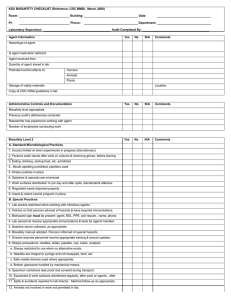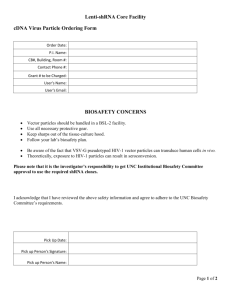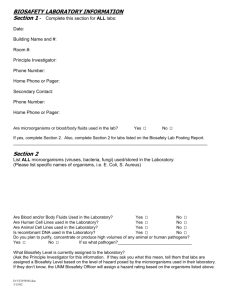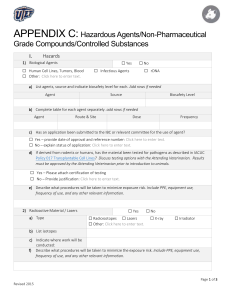Standard Microbiological Practices for All Life Science Lab
advertisement
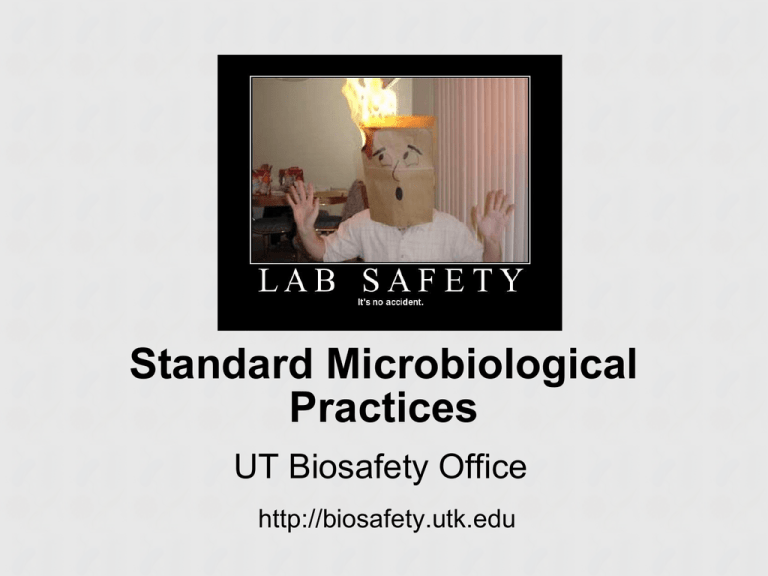
Standard Microbiological Practices UT Biosafety Office http://biosafety.utk.edu Standard Microbiological Practices (SMP) What are they? • Basic “hygiene” practices that apply to all labs and clinics that manipulate microorganisms or biological materials that contain microorganisms. What’s their purpose? • To minimize the spread of contamination generated through the lab processes to protect both personnel and the environment. Standard Microbiological Practices (SMP) SMP’s apply to a broad spectrum of activities including: • Manipulation of any microbes including bacteria, viruses, fungi, and protozoa. • Manipulation of materials that may contain microbes including animal and plant tissues, soil samples, and water samples. • Receiving, processing, and testing of diagnostic samples. • Research involving recombinant DNA molecules, transgenic animals, or genetically modified plants. • Manipulation of animals or plants that are experimentally infected with microbes. • Work with biological toxins and other bioactive molecules. Biohazards This symbol indicates that there is a biological material that can cause harm to yourself, others in the lab, or the environment. Use caution whenever you see this symbol. Speak to your advisor for additional information about the biohazards present in the lab. Lab Hygiene: The Basics • Do not store food or drink in lab. • Do not consume food or drink in the lab. • Do not apply facial cosmetics (including lipstick, lip balm, etc.) in lab. • Keep personal items out of areas where biological or other hazardous materials are manipulated or stored. Lab Hygiene: Hand Washing • Extremely important SMP! – Reduces accidental infection risk – Minimizes spread of contamination • Use soap and running water. • Lather for 20-30 seconds. • Waterless hand cleaners may be used if soap/water aren’t available, but hands should be properly washed as soon as possible. Proper response to an exposure can reduce your risk of an infection… If potentially infectious materials enter your body through: – A cut or puncture with a contaminated sharp – Entry through broken skin – A splash to the eyes, nose or mouth – Accidental ingestion You must: – Flush the exposed area (15 minutes) – Immediately report to your supervisor Personal Protective Equipment (PPE) Use personal protective equipment (PPE) when handling or manipulating biological materials (including wastes) to prevent accidental exposures. Some types of PPE are gloves, lab coat, safety goggles, and safety glasses. Sharps Safety Some examples of sharps are needles, scalpels, and contaminated broken glassware. These materials must be handled in a safe manner. • Do not handle sharps with 2 hands. • Don’t pass a sharp device from one hand to another. • Don’t recap needles or scalpels! Waste Segregation There are different types of biological waste. Sometimes biological waste is mixed with chemical waste. Speak with your advisor on how to dispose of your research waste properly. Research waste does not go into a regular trash can. Disinfect all contaminated surfaces after procedures. • • • • Clean surfaces of visible debris before you disinfect. Know your disinfectant before you use it. Refer to the manufacturer’s instructions. Questions to ask before selecting a disinfectant: – Is the product effective for organisms of concern? – Is the product designed for your application? – What are the hazards to the user and what PPE is required? – What is the dilution ratio? – Contact time? – Shelf-life? Transporting Biological Materials Biological materials should be stored in primary containers that are designed to contain the material inside. Use sample containers that are manufactured for that purpose. Do not hand-carry primary containers outside the lab without a secondary container. A secondary container is intended to capture leakage or spillage from the primary container. Therefore a suitable secondary container for moving materials within a building should be: • Have a lid if used for transporting primary containers that are open. • Leak-proof on the sides and bottom • Non-breakable • Have raised sides • Easy to grasp (ideally, have a handle) Containment devices Below is a chemical fume hood. This is only to used for handling chemicals. Above is a biosafety cabinet. This is to be used for handling biological materials that are infectious. Get training from your supervisor PRIOR to using either containment device. If you have any questions, contact the Biosafety Office Brian Ranger, MS, SM(NRCM), CBSP Biosafety Officer, UTK/UTIA/GSM 974-1938 or branger@utk.edu OR Sarah DiFurio, MS, RBP Biosafety Specialist, UTK/UTIA/GSM 974-9836 or sbottomL@utk.edu http://biosafety.utk.edu Quiz Time To complete the Staying Safe in the Laboratory Training Module, please click here for the quiz.
